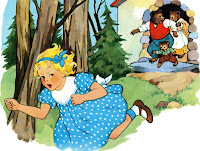What Baby Bear's Bed can teach writers about setting by Andrew J Chamberlain
We all know the story of Goldilocks
and the three bears, but in case it’s been a while since you enjoyed this
delightful little tale here’s a summarised version with the relevant sections included
for this blog.
Once upon a time,
there was a little girl named Goldilocks.
She went for a walk in the forest, and pretty soon, she came upon a
house. She knocked and, when no one
answered, she walked right in.
At the table in the
kitchen, there were three bowls of porridge.
She tasted the porridge from the first bowl.
"This porridge is
too hot!" she exclaimed.
So, she tasted the
porridge from the second bowl.
"This porridge is
too cold," she said
So, she tasted the
last bowl of porridge.
"Ahhh, this
porridge is just right," she said happily and she ate it all up.
After she'd eaten the
three bears' breakfasts she decided she was feeling a little tired, so she went
upstairs to the bedroom. She lay down in
the first bed, but it was too hard. Then
she lay in the second bed, but it was too soft.
Then she lay down in the third bed and it was just right. Goldilocks fell asleep.
As she was sleeping,
the three bears came home.
"Someone's been
eating my porridge," growled the Papa bear.
"Someone's been
eating my porridge," said the Mama bear.
"Someone's been
eating my porridge and they ate it all up!" cried the Baby bear.
They decided to look
around some more and when they got upstairs to the bedroom, Papa bear growled,
"Someone's been sleeping in my bed,"
"Someone's been
sleeping in my bed, too" said the Mama bear
"Someone's been
sleeping in my bed and she's still there!" exclaimed Baby bear.
Just then, Goldilocks
woke up and saw the three bears. She
jumped up and ran out of the room.
Goldilocks ran down the stairs, opened the door, and ran away into the
forest. And she never returned to the
home of the three bears.
Unlikely though it may seem, the latter part of this story
can teach us a valuable lesson about setting in the craft of storytelling.
The two essential
qualities of setting.
The essential ingredients of a story setting are that it needs
to be both credible and immersive.
By credible I mean it has to be believable (which is
different from it being true).
A credible story
is one that is consistent within itself and accurate in terms of the detail
that it does give us, so even in a fiction story the details that should be
accurate and correct must be. So for example if your story is set in London and
you have your character walk from Waterloo Station to Camden Market, a journey
of about three and a half miles, that walk is going to take about an hour. If
you have your character walk that journey is ten minutes, and the reader knows
how far the distance is, they know you’ve made a mistake. The setting becomes
inaccurate, and therefore not credible. The reader will not trust themselves to
your setting or your story.
But setting also has to be immersive. This means that as well as believing in the environment
you’ve created, the reader needs to be able to immerse themselves in it; there
has to be enough rich detail, enough colour and vibrancy and life to draw them
in. Imagine the story of “Charlie and the Chocolate factory”, but told as
“Charlie and the production line” where the factory is just a production line that
makes identical components. The setting can be factually correct and therefore credible,
but it will be very dull compared to the sensory extravaganza that is Willy
Wonka’s chocolate factory.
 The credible story that is not immersive is like Papa Bear’s
bed, it’ll take our weight as readers, but it’s too hard, it won’t hold our
attention.
The credible story that is not immersive is like Papa Bear’s
bed, it’ll take our weight as readers, but it’s too hard, it won’t hold our
attention. By comparison, the immersive story that is not credible is
like Mama Bear’s bed, it’s just not something we trust ourselves to, it’s too
soft, we don’t trust it.
By comparison, the immersive story that is not credible is
like Mama Bear’s bed, it’s just not something we trust ourselves to, it’s too
soft, we don’t trust it.
The ideal setting, therefore, is just like baby bears bed,
which is neither too hard nor too soft, it’s just right, being both credible
and immersive, and whilst we don’t want our readers to fall asleep as Goldilocks
did (!) we do want them to feel comfortable with our setting and our story.
It’s these two essential components – that the setting is credible and immersive,
that will achieve this.
*
Andrew Chamberlain is a writer and creative writing tutor. He is a commercial
publisher of fiction and memoir and the presenter of the creative writer’s
podcast: The Creative Writer’s Toolbelt, he is also the author of The Creative Writer’s Toolbelt Handbook which contains the best advice and
insight from 100 episodes of the podcast.



Comments
Post a Comment